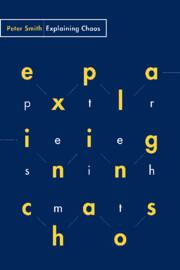2 - Fractal intricacy
Published online by Cambridge University Press: 22 September 2009
Summary
Chaos – of the sort that concerns us – is a feature of certain dynamical models which exhibit sensitive dependence on initial conditions plus ‘confinement’ plus (typical) aperiodicity. Which is to say, roughly, that tiny differences in initial states can exponentially inflate into big differences in later states, but the values of the relevant state variables eventually remain confined within fixed boundaries although typically never exactly repeating.
Consider again, in the most general terms, how we can get sensitive dependence and confinement. Sensitive dependence means that trajectories through nearby points must tend to spread further apart from each other, confinement means that trajectories need to fold back on themselves so they keep within bounds. This kind of continual spreading and folding back is going to lead to a pretty tangled ball of possible trajectories. In fact, if there is typically to be no exact repetition, and also no merging or crossing of trajectories, then the ball must have a kind of infinite complexity. Since any given aperiodic trajectory will (eventually) be confined inside a finite region, it will have to keep revisiting some neighbourhoods of its earlier locations indefinitely often as it unendingly winds round and round. So segments of trajectories will have to be packed into such neighbourhoods infinitely densely.
Information
- Type
- Chapter
- Information
- Explaining Chaos , pp. 20 - 38Publisher: Cambridge University PressPrint publication year: 1998
